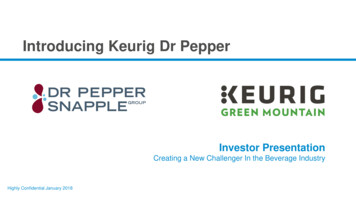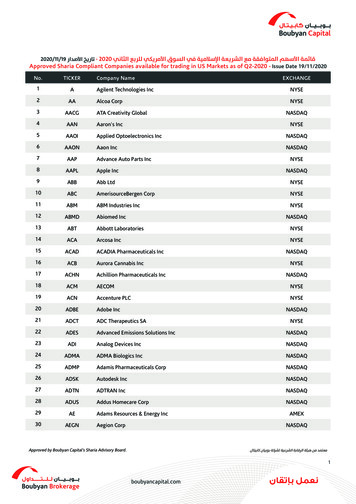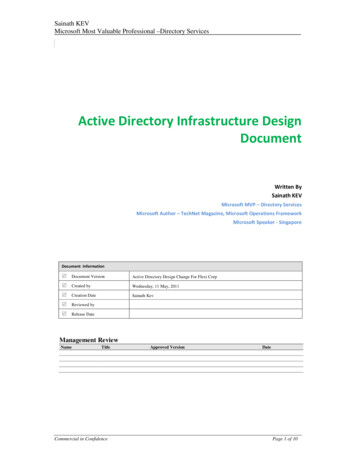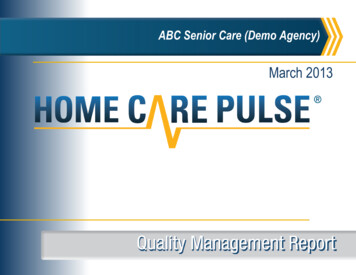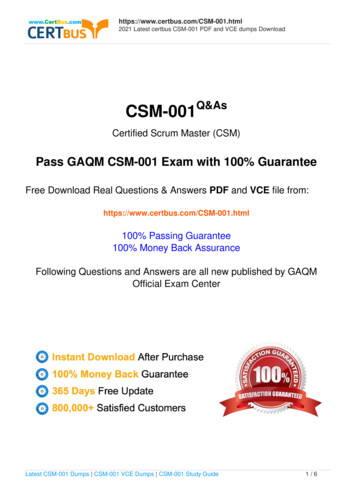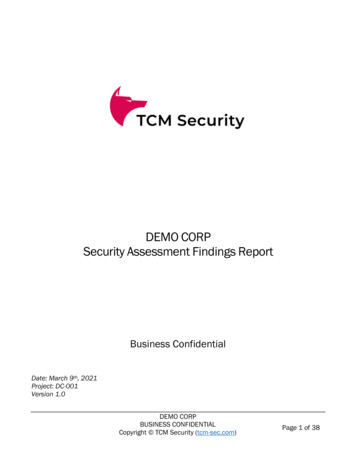
Transcription
DEMO CORPSecurity Assessment Findings ReportBusiness ConfidentialDate: March 9th, 2021Project: DC-001Version 1.0DEMO CORPBUSINESS CONFIDENTIALCopyright TCM Security (tcm-sec.com)Page 1 of 38
Table of ContentsTable of Contents . 2Confidentiality Statement . 4Disclaimer . 4Contact Information. 4Assessment Overview. 5Assessment Components . 5Internal Penetration Test . 5Finding Severity Ratings . 6Risk Factors . 6Likelihood . 6Impact. 6Scope. 7Scope Exclusions . 7Client Allowances . 7Executive Summary . 8Scoping and Time Limitations. 8Testing Summary . 8Tester Notes and Recommendations . 9Key Strengths and Weaknesses .10Vulnerability Summary & Report Card. 11Internal Penetration Test Findings .11Technical Findings . 13Internal Penetration Test Findings .13Finding IPT-001: Insufficient LLMNR Configuration (Critical) . 13Finding IPT-002: Security Misconfiguration – Local Admin Password Reuse (Critical) . 14Finding IPT-003: Security Misconfiguration – WDigest (Critical) . 15Finding IPT-004: Insufficient Hardening – Token Impersonation (Critical). 16Finding IPT-005: Insufficient Password Complexity (Critical) . 17Finding IPT-006: Security Misconfiguration – IPv6 (Critical) . 18Finding IPT-007: Insufficient Hardening – SMB Signing Disabled (Critical) . 19Finding IPT-008: Insufficient Patch Management – Software (Critical) . 20Finding IPT-009: Insufficient Patch Management – Operating Systems (Critical) . 21Finding IPT-010: Insufficient Patching – MS08-067 - ECLIPSEDWING/NETAPI (Critical) . 22Finding IPT-011: Insufficient Patching – MS12-020 – Remote Desktop RCE (Critical) . 23Finding IPT-012: Insufficient Patching – MS17-010 - EternalBlue (Critical) . 24Finding IPT-013: Insufficient Patching – CVE-2019-0708 - BlueKeep (Critical) . 25Finding IPT-014: Insufficient Privileged Account Management – Kerberoasting (High) . 26DEMO CORPBUSINESS CONFIDENTIALCopyright TCM Security (tcm-sec.com)Page 2 of 38
Finding IPT-015: Security Misconfiguration – GPP Credentials (High) . 27Finding IPT-016: Insufficient Authentication - VNC (High) . 28Finding IPT-017: Default Credentials on Web Services (High) . 29Finding IPT-018: Insufficient Hardening – Listable Directories (High). 30Finding IPT-019: Unauthenticated SMB Share Access (Moderate) . 31Finding IPT-020: Insufficient Patch Management – SMBv1 (Moderate) . 32Finding IPT-021: IPMI Hash Disclosure (Moderate) . 33Finding IPT-022: Insufficient SNMP Community String Complexity (Moderate) . 34Finding IPT-023: Insufficient Data in Transit Encryption - Telnet (Moderate). 35Finding IPT-024: Insufficient Terminal Services Configuration (Moderate) . 36Finding IPT-025: Steps to Domain Admin (Informational) . 37Additional Scans and Reports.37DEMO CORPBUSINESS CONFIDENTIALCopyright TCM Security (tcm-sec.com)Page 3 of 38
Confidentiality StatementThis document is the exclusive property of Demo Corp and TCM Security (TCMS). This documentcontains proprietary and confidential information. Duplication, redistribution, or use, in whole or inpart, in any form, requires consent of both Demo Corp and TCMS.Demo Corp may share this document with auditors under non-disclosure agreements to demonstratepenetration test requirement compliance.DisclaimerA penetration test is considered a snapshot in time. The findings and recommendations reflect theinformation gathered during the assessment and not any changes or modifications made outside ofthat period.Time-limited engagements do not allow for a full evaluation of all security controls. TCMS prioritizedthe assessment to identify the weakest security controls an attacker would exploit. TCMSrecommends conducting similar assessments on an annual basis by internal or third-party assessorsto ensure the continued success of the controls.Contact InformationNameDemo CorpJohn SmithTCM SecurityHeath AdamsTitleContact InformationGlobal Information SecurityEmail: jsmith@democorp.comManagerLead Penetration TesterEmail: heath@tcm-sec.comDemo CorpBUSINESS CONFIDENTIALCopyright TCM Security (tcm-sec.com)Page 4 of 38
Assessment OverviewFrom February 22nd, 2021 to March 5th, 2021, Demo Corp engaged TCMS to evaluate the securityposture of its infrastructure compared to current industry best practices that included an internalnetwork penetration test. All testing performed is based on the NIST SP 800-115 Technical Guide toInformation Security Testing and Assessment, OWASP Testing Guide (v4), and customized testingframeworks.Phases of penetration testing activities include the following: Planning – Customer goals are gathered and rules of engagement obtained.Discovery – Perform scanning and enumeration to identify potential vulnerabilities, weakareas, and exploits.Attack – Confirm potential vulnerabilities through exploitation and perform additionaldiscovery upon new access.Reporting – Document all found vulnerabilities and exploits, failed attempts, and companystrengths and weaknesses.Assessment ComponentsInternal Penetration TestAn internal penetration test emulates the role of an attacker from inside the network. An engineerwill scan the network to identify potential host vulnerabilities and perform common and advancedinternal network attacks, such as: LLMNR/NBT-NS poisoning and other man- in-the-middle attacks,token impersonation, kerberoasting, pass-the-hash, golden ticket, and more. The engineer will seekto gain access to hosts through lateral movement, compromise domain user and admin accounts,and exfiltrate sensitive data.Demo CorpBUSINESS CONFIDENTIALCopyright TCM Security (tcm-sec.com)Page 5 of 38
Finding Severity RatingsThe following table defines levels of severity and corresponding CVSS score range that are usedthroughout the document to assess vulnerability and risk impact.SeverityCVSS V3Score RangeCritical9.0-10.0Exploitation is straightforward and usually results in system-levelcompromise. It is advised to form a plan of action and patchimmediately.High7.0-8.9Exploitation is more difficult but could cause elevated privileges andpotentially a loss of data or downtime. It is advised to form a plan ofaction and patch as soon as possible.Moderate4.0-6.9Vulnerabilities exist but are not exploitable or require extra steps suchas social engineering. It is advised to form a plan of action and patchafter high-priority issues have been resolved.Low0.1-3.9Vulnerabilities are non-exploitable but would reduce an organization’sattack surface. It is advised to form a plan of action and patch duringthe next maintenance window.InformationalN/ADefinitionNo vulnerability exists. Additional information is provided regardingitems noticed during testing, strong controls, and additionaldocumentation.Risk FactorsRisk is measured by two factors: Likelihood and Impact:LikelihoodLikelihood measures the potential of a vulnerability being exploited. Ratings are given based on thedifficulty of the attack, the available tools, attacker skill level, and client environment.ImpactImpact measures the potential vulnerability’s effect on operations, including confidentiality, integrity,and availability of client systems and/or data, reputational harm, and financial loss.Demo CorpBUSINESS CONFIDENTIALCopyright TCM Security (tcm-sec.com)Page 6 of 38
ScopeAssessmentInternal Penetration TestDetails10.x.x.x/8Scope ExclusionsPer client request, TCMS did not perform any of the following attacks during testing: Denial of Service (DoS) Phishing/Social EngineeringAll other attacks not specified above were permitted by Demo Corp.Client AllowancesDemo Corp provided TCMS the following allowances: Internal access to network via dropbox and port allowancesDemo CorpBUSINESS CONFIDENTIALCopyright TCM Security (tcm-sec.com)Page 7 of 38
Executive SummaryTCMS evaluated Demo Corp’s internal security posture through penetration testing from February22nd, 2021 to March 5th, 2021. The following sections provide a high-level overview of vulnerabilitiesdiscovered, successful and unsuccessful attempts, and strengths and weaknesses.Scoping and Time LimitationsScoping during the engagement did not permit denial of service or social engineering across alltesting components.Time limitations were in place for testing. Internal network penetration testing was permitted for ten(10) business days.Testing SummaryThe network assessment evaluated Demo Corp’s internal network security posture. From an internalperspective, the TCMS team performed vulnerability scanning against all IPs provided by Demo Corpto evaluate the overall patching health of the network. The team also performed common ActiveDirectory based attacks, such as Link-Local Multicast Name Resolution (LLMNR) Poisoning, SMBrelaying, IPv6 man-in-the-middle relaying, and Kerberoasting. Beyond vulnerability scanning andActive Directory attacks, the TCMS evaluated other potential risks, such as open file shares, defaultcredentials on servers/devices, and sensitive information disclosure to gain a complete picture ofthe network’s security posture.The TCMS team discovered that LLMNR was enabled in the network (Finding IPT-001), whichpermitted the interception of user hashes via LLMNR poisoning. These hashes were taken offlineand cracked via dictionary attacks, which signals a weak password policy (Finding IPT-005). Utilizingthe cracked passwords, the TCMS team gained access to several machines within the network, whichindicates overly permissive user accounts.With machine access, and the use of older operating systems in the network (Finding IPT-009), theteam was able to leverage WDigest (Finding IPT-003) to recover cleartext credentials to accounts.The team was also able to dump local account hashes on each machine accessed. The TCMS teamdiscovered that the local account hashes were being re-used across devices (Finding IPT-002), whichlead to additional machine access through pass-the-hash attacks.Ultimately, the TCMS team was able to leverage accounts captured through WDigest and hash dumpsto move laterally throughout the network until landing on a machine that had a Domain Administratorcredential in cleartext via WDigest. The testing team was able to use this credential to log into thedomain controller and compromise the entire domain. For a full walkthrough of the path to DomainAdmin, please see Finding IPT-025.Demo CorpBUSINESS CONFIDENTIALCopyright TCM Security (tcm-sec.com)Page 8 of 38
In addition to the compromise listed above, the TCMS team found that users could be impersonatedthrough delegation attacks (Finding IPT-004), SMB relay attacks were possible due to SMB signingbeing disabled (Finding IPT-007), and IPv6 traffic was not restricted, which could lead to LDAPSrelaying and domain compromise (Finding IPT-006).The remainder of critical findings relate to patch management as devices with critical out-of-datesoftware (Finding IPT-008), operating systems (Finding IPT-009), and Microsoft RCE vulnerabilities(Findings IPT-010, IPT-011, IPT-012, IPT-013), were found to be present within the network.The remainder of the findings were high, moderate, low, or informational. For further information onfindings, please review the Technical Findings section.Tester Notes and RecommendationsTesting results of the Demo Corp network are indicative of an organization undergoing its firstpenetration test, which is the case here. Many of the findings discovered are vulnerabilities withinActive Directory that come enabled by default, such as LLMNR, IPv6, and Kerberoasting.During testing, two constants stood out: a weak password policy and weak patching. The weakpassword policy led to the initial compromise of accounts and is usually one of the first footholds anattacker attempts to use in a network. The presence of a weak password policy is backed up by theevidence of our testing team cracking over 2,200 user account passwords, including a majority ofthe Domain Administrator accounts, through basic dictionary attacks.We recommended that Demo Corp re-evaluates their current password policy and considers a policyof 15 characters or more for their regular user accounts and 30 characters or more for their DomainAdministrator accounts. We also recommend that Demo Corp explore password blacklisting and willbe supplying a list of cracked user passwords for the team to evaluate. Finally, a Privilege AccessManagement solution should be considered.Weak patching and dated operating systems led to the compromise of dozens of machines withinthe network. We believe the number of compromised machines would have been significantly larger,however the TCMS and Demo Corp teams agreed it was not necessary to attempt to exploit anyremote code execution (RCE) based vulnerabilities, such as MS17-010 (Finding IPT-012), as thedomain controller had already been compromised and the teams did not want to risk any denial ofservice through failed attacks.We recommend that the Demo Corp team review the patching recommendations made in theTechnical Findings section of the report along with reviewing the provided Nessus scans for a fulloverview of items to be patched. We also recommend that Demo Corp improve their patchmanagement policies and procedures to help prevent potential attacks within their network.Demo CorpBUSINESS CONFIDENTIALCopyright TCM Security (tcm-sec.com)Page 9 of 38
On a positive note, our testing team triggered several alerts during the engagement. The Demo CorpSecurity Operations team discovered our vulnerability scanning and was alerted when we attemptedto use noisy attacks on a compromised machine. While not all attacks were discovered duringtesting, these alerts are a positive start. Additional guidance on alerting and detection has beenprovided for findings, when necessary, in the Technical Findings section.Overall, the Demo Corp network performed as expected for a first-time penetration test. Werecommend that the Demo Corp team thoroughly review the recommendations made in this report,patch the findings, and re-test annually to improve their overall internal security posture.Key Strengths and WeaknessesThe following identifies the key strengths identified during the assessment:1.2.3.4.Observed some scanning of common enumeration tools (Nessus)Mimikatz detected on some machinesService accounts were not running as domain administratorsDemo Corp local administrator account password was unique to each deviceThe following identifies the key weaknesses identified during the assessment:1. Password policy found to be insufficient2. Critically out-of-date operating systems and weak patching exist within the network3. Passwords were observed in cleartext due to WDigest4. LLMNR is enabled within the network5. SMB signing is disabled on all non-server devices in the work6. IPv6 is improperly managed within the network7. User accounts can be impersonated through token delegation8. Local admin accounts had password re-use and were overly permissive9. Default credentials were discovered on critical infrastructure, such as iDRACs10. Unauthenticated share access was permitted11. User accounts were found to be running as service accounts12. Service accounts utilized weak passwords13. Domain administrator utilized weak passwordsDemo CorpBUSINESS CONFIDENTIALCopyright TCM Security (tcm-sec.com)Page 10 of 38
Vulnerability Summary & Report CardThe following tables illustrate the vulnerabilities found by impact and recommended remediations:Internal Penetration Test FindingInternal Penetration TestSeverityRecommendationIPT-001: Insufficient LLMNRConfigurationIPT-002: Security Misconfiguration –Local Admin Password ReuseCriticalIPT-003: Security Misconfiguration –WdigestIPT-004: Insufficient Hardening –Token ImpersonationIPT-005: Insufficient PasswordComplexityIPT-006: Security Misconfiguration –IPv6CriticalDisable multicast name resolution viaGPO.Utilize unique local admin passwordsand limit local admin users via leastprivilege.Disable WDigest via GPO.CriticalRestrict token delegation.CriticalIPT-007: Insufficient Hardening –SMB Signing DisabledIPT-008: Insufficient PatchManagement – SoftwareIPT-009: Insufficient PatchManagement – Operating SystemsIPT-010: Insufficient Patching –MS08-067 - ECLIPSEDWING/NETAPIIPT-011: Insufficient Patching –MS12-020 – Remote Desktop RCEIPT-012: Insufficient Patching –MS17-010 - EternalBlueIPT-013: Insufficient Patching – CVE2019-0708 - BlueKeepCriticalImplement CIS Benchmark passwordrequirements / PAM solution.Restrict DHCPv6 traffic and incomingrouter advertisements in WindowsFirewall via GPO.Enable SMB signing on all Demo Corpdomain computers.Update to the latest software iticalCriticalCriticalUpdate Operating Systems to thelatest version.Apply the appropriate Microsoftpatches to remediate the issue.Apply the appropriate Microsoftpatches to remediate the issue.Apply the appropriate Microsoftpatches to remediate the issue.Apply the appropriate Microsoftpatches to remediate the issue.Demo CorpBUSINESS CONFIDENTIALCopyright TCM Security (tcm-sec.com)Page 11 of 38
FindingSeverityRecommendationIPT-014: Insufficient PrivilegedAccount Management –KerberoastingIPT-015: Security Misconfiguration –GPP CredentialsIPT-016: Insufficient Authentication VNCIPT-017: Default Credentials on WebServicesIPT-018: Insufficient Hardening –Listable DirectoriesIPT-019: Unauthenticated SMB ShareAccessIPT-020: Insufficient PatchManagement – SMBv1IPT-021: IPMI Hash DisclosureHighModerateUse Group Managed ServiceAccounts (GMSA) for privilegedservices.Apply vendor patching. Do not useGPP cpasswords.Enable authentication on the VNCServer.Change default credentials or disableunused accounts.Restrict access and conduct web appassessment.Disable SMB share or requireauthentication.Upgrade to SMBv3 and apply latestpatching.Disable IPMI over LAN if it is notneeded.Disabled SNMP if not required.ModerateMigrate to TLS protected protocols.ModerateEnable Network Level Authentication(NLA) on the remote RDP server.Review action and remediation steps.IPT-022: Insufficient SNMPCommunity String ComplexityIPT-023: Insufficient Data in TransitEncryption - TelnetIPT-024: Insufficient TerminalServices ConfigurationIPT-025: Steps to Domain mationalDemo CorpBUSINESS CONFIDENTIALCopyright TCM Security (tcm-sec.com)Page 12 of 38
Technical FindingsInternal Penetration Test FindingsFinding IPT-001: Insufficient LLMNR Configuration (Critical)Description:Demo Corp allows multicast name resolution on their end-user networks. TCMScaptured 20 user account hashes by poisoning LLMNR traffic and cracked 2with commodity cracking software.Risk:System:Tools Used:References:The cracked accounts were used to leverage further access that led to thecompromise of the Domain Controller.Likelihood: High – This attack is effective in environments allowing multicastname resolution.Impact: Very High – LLMNR poisoning permits attackers to capture passwordhashes to either crack offline or relay in real-time and pivot laterally in theenvironment.AllResponder, HashcatStern Security - Local Network Attacks: LLMNR and NBT-NS PoisoningNIST SP800-53 r4 IA-3 - Device Identification and AuthenticationNIST SP800-53 r4 CM-6(1) - Configuration SettingsEvidenceFigure 1: Captured hash of “production”Figure 2: Cracked hash of “production”RemediationDisable multicast name resolution via GPO. For full mitigation and detection guidance, pleasereference the MITRE guidance here.The cracked hashes demonstrate a deficient password complexity policy. If multicast nameresolution is required, Network Access Control (NAC) combined with application whitelisting canlimit these attacks.Demo CorpBUSINESS CONFIDENTIALCopyright TCM Security (tcm-sec.com)Page 13 of 38
Finding IPT-002: Security Misconfiguration – Local Admin Password Reuse (Critical)Description:TCMS utilized local administrator hashes to gain access to other machines inthe network via a ‘pass-the-hash’ attack. The local administrator hashes wereobtained via machine access provided by the cracked account in IPT-001.Pass-the-hash attacks do not require knowing the account password tosuccessfully log into a machine. Thus, reusing the same local admin password(and therefore the same hash) on multiple machines will permit system accessto those computers.Risk:System:Tools Used:References:TCMS leveraged this attack to gain access to 50 machines within the mainoffice. This led to further account access and the eventual compromise of thedomain controller.Likelihood: High – This attack is effective in large networks with local adminpassword reuse.Impact: Very High – Pass-the-hash permits an attacker to move laterally andvertically throughout the network.AllImpacket, ou-spent-how-much-on-security/EvidenceFigure 3: Local admin hash used to gain access to machineRemediationUtilize unique local admin passwords. Limit local admin users via least privilege. Considerimplementing a PAM solution. For full mitigation and detection guidance, please reference theMITRE guidance here.Demo CorpBUSINESS CONFIDENTIALCopyright TCM Security (tcm-sec.com)Page 14 of 38
Finding IPT-003: Security Misconfiguration – WDigest (Critical)Description:Demo Corp permitted out-of-date operating systems within their network,including Windows 7, 8, Server 2008, and Server 2012.These operating systems, by default, permit WDigest, which stores all currentlogged-in user’s passwords in clear-text.Risk:System:Tools Used:References:TCMS leveraged machine access gained in IPT-001 and IPT-002 to movelaterally throughout the network until uncovering a machine with Domain Admincredentials stored in WDigest.Likelihood: Moderate – This attack is effective in networks with older operatingsystems.Impact: Very High – WDigests credentials are stored in clear text, which canpermit the theft of sensitive accounts, such as Domain Administrators.All systems older than Windows 10 and Server 2016Metasploit, e 4: Cleartext passwords of Domain AdministratorsRemediationDisable WDigest via GPO. For full mitigation and detection guidance, please reference theguidance here.Demo CorpBUSINESS CONFIDENTIALCopyright TCM Security (tcm-sec.com)Page 15 of 38
Finding IPT-004: Insufficient Hardening – Token Impersonation (Critical)Description:TCMS impersonated the token of “supcb” to obtain Domain Administratorprivileges.Risk:Likelihood: High – The penetration tester viewed and impersonated tokens withthe use of open-source tools.System:Tools Used:References:Impact: Very High - If exploited, an attacker gains domain administrator access.AllMetasploit, IncognitoNIST SP800-53 r4 CM-7 - Least FunctionalityNIST SP800-53 r4 AC-6 - Least server/identity/adds/manage/how-to-configure- protected-accountsEvidenceFigure 5: Impersonation of “sup”Figure 6: Shell access as Domain Admin “sup”RemediationRestrict token delegation. For full mitigation and detection guidance, please reference the MITREguidance here.Demo CorpBUSINESS CONFIDENTIALCopyright TCM Security (tcm-sec.com)Page 16 of 38
Finding IPT-005: Insufficient Password Complexity (Critical)Description:TCMS dumped hashes from the domain controller and proceeded to attemptcommon password guessing attacks against all users.Risk:System:Tools Used:References:TCMS cracked 2,226 passwords using basic password list guessing attacks andlow effort brute forcing attacks. 17 cracked accounts had domain administratorrights.Likelihood: High - Simple passwords are susceptible to password crackingattacks. Encryption provides some protection, but dictionary attacks base oncommon word lists often crack weak passwords.Impact: Very High - Domain admin accounts with weak passwords could lead toan adversary critically impacting Demo Corp ability to operate.AllManual ReviewNIST SP800-53 IA-5(1) - Authenticator cis-password-policy-guide/EvidenceFigure 7: Excerpt of cracked domain hashesRemediationImplement CIS Benchmark password requirements / PAM solution. TCMS recommends that DemoCorp enforce industry best practices around password complexity and management. A passwordfilter to prevent users from using common and easily guessable passwords is also recommended.Additionally, TCMS recommends that Demo Corp enforce stricter password requirements forDomain Administrator and other sensitive accounts.Demo CorpBUSINESS CONFIDENTIALCopyright TCM Security (tcm-sec.com)Page 17 of 38
Finding IPT-006: Security Misconfiguration – IPv6 (Critical)Description:Through IPv6 DNS poisoning, the TCMS team was able to successfully relaycredentials to the Demo Corp domain controller.Risk:Likelihood: High – IPv6 is enabled by default on Windows networks. The toolsand techniques required to perform this task are trivial.System:Tools Used:References:Impact: Very High - If exploited, an attacker can gain domain administratoraccess.AllMitm6, ompromising-ipv4-networks-viaipv6/EvidenceFigure 8: Successfully relayed LDAP credentials via mitm6Remediation1. IPv6 poisoning abuses the fact that Windows queries for an IPv6 address even in IPv4-onlyenvironments. If you do not use IPv6 internally, the safest way to prevent mitm6
SP 800-115 Technical Guide to Information Security Testing and Assessment, OWASP Testing Guide (v4), and customized testing frameworks. Phases of penetration testing activities include the following: Planning – Cust
